|
Last Updated -
30th October 2014
I have spent the last 7 years capturing all sorts of images and most, if
not all of them, are very similar to images that everyone else captures.
Its difficult to broaden my photography, to find a new 'niche' and every
now and then, I turn towards the idea of photographic art.
Photographic art is a very interesting diversion for a photographer to
undertake. Sometimes we all capture that 'great shot' and very often it
makes a statement and the image just leaps forward and shouts "Art".
When
the question of ART is
raised in relation to
photography the debate can
run off in many strands,
surrealism, impressionism,
social realism
and fine art are a few
that I could mention. The
definition of art is now so
pretentious, that many art
critics regard the thought
of photography as an art
form to be heresy.
My
good friend,
Roy, recently sent me
a photograph 'Breath
on Piano'
by Gabriel Orozco and asked
me
"is this photo a great
piece of art". Roy
is currently undertaking a
course on
Art Appreciation:
Photography as Art
so this hot topic
is
well debated.
I replied
"Ah the fleeting moment, the trace of the breath on cold lacquered
wood, the presence of a
person in time marking their
visible presence".
'Breath on Piano'
is accepted as photographic
art because of the presumed
statement the image delivers
and more so because of the
accepted personage of the
artist. I am sure that many
of the Orozco faithful will
have a print copy adoring
the wall of their modern
house. If the image had
been created by a student of
Orozco, I doubt it would
have reached such
prominence?
There are very few
photographers who have a eye
for art in that 'Decisive
Moment' and
many will experiment and
stage their photography in
an
attempt to create art; some
will even spend hours in
software post processing to
create their own
interpretation of art and
some will regard the
practice of 'The
Purism
in Photography'
as art itself.
In the end, their print
will sit proud on the walls
of aficionados or lying in a
dustbin upon their death.
This image was shot on a
beautiful sunny day in the graveyard at Peebles in Scotland without a
flashgun and the 'RAW' colour image was hacked using Adobe Lightroom 5
software and converted to black and white. Is it art - who cares, I
remember the moment as clear as the day I captured it, my mother who is
92 years old was walking with her stick, the hot sun was beating down on
her face and she was smiling -
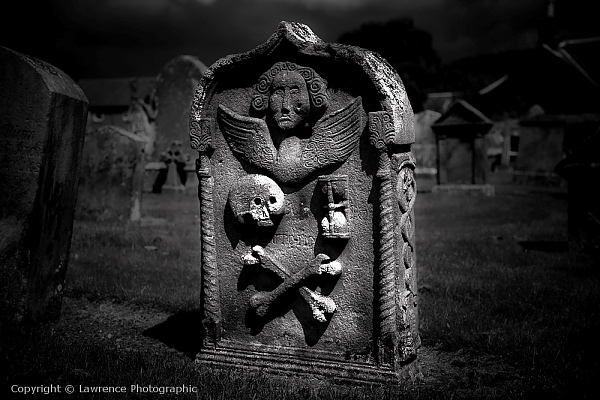
It's a sobering thought that
your lifetime of work could be
chucked out in the bin on
your death, all those hours
at the computer, hacking
away to create your ultimate
'work of art' and then thrown
away along with the garbage!
A number of photographers define photography 'as art' but I think it has
to go a little deeper for it to be called art? We are all creators, I
think that is the mainstay of photography, we like to create images and
no matter what some will say, we do appreciate them being admired.
I could get into the debate on 'forums' about what defines any form of 'art in
photography' but the subject invariably draws all kinds of answers and it
becomes so complex and argumentative that a firm definition is never
reached.
My own approach to art photography is the recognition that I will have
to work very hard to achieve it and if I am lucky enough to develop the
thinking of an artist in my photography then I may be successful? Most
photographic art is actual in the subject material of the photography,
rather than altering the photograph itself but the hardest part is in
recognising that material. Emotion has always been associated with art,
therefore I think that a photographer has to capture images that draw
out emotion? It could be argued that all those black and white
photographic images that were taken years ago (even today) are not true
art by merely reflections or 'snapshots' of the past but then many do
draw out emotion and enhance our perceptions of the past and the
present. There are no conclusions in what I have just written, it only
serves to open up an endless debate..........a debate about 'what is
art' which has been going on for centuries!
One answer that does make sense...........you throw away the technical
rules of photography and use the eye and mind of an artist who can visualise the image in software post processing mode or in painted mode.
When you
visit other websites that specialise in photographic art you will find
that they can be quite diverse. As I wrote above, art can be defined by
a statement from the content of a photograph, similar to what you may
find in a street image or the photograph itself can be turned into a work
of art. This is one of my attempts to turn a camera digital 'RAW' image
file into a different rendering, similar to a painting -
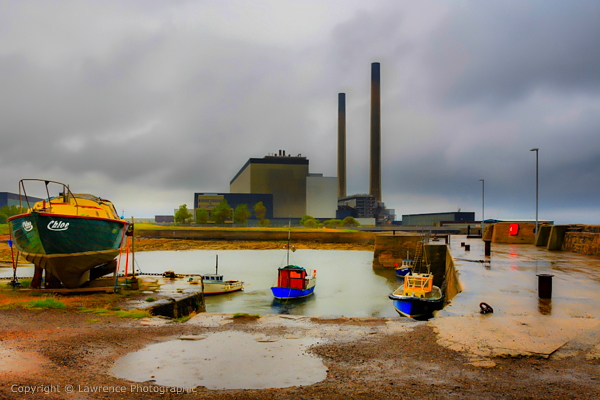
I often imagine that I am doing well with my little efforts at
converting my images into works of art............then I visit some of
these sites!
Twisted Tree
is
certainly a site that you can learn from. It is simply breath taking and
the monochrome images will blow your mind! The site takes you through
standard colour photography to monochrome HDR and into the realms of
impressionist art..............worth checking out for any photographer who
aspires to make a start in photographic art!
Joe Cornish
is well known in the UK and
his landscape work is very much in art form. You really don't have to
search for it, it requires no interpretation, it is just 'art'!
Erwin Olaf has a site worth visiting
for its examples of modern art photography. His work ( for me) is just a little
bit of the wall but fascinating to view. It is very deliberate 'staged'
art, although I am not qualified to quote any interpretation!
Rui Palha
is a street
photographer who has some very interesting work on his site. Enlarge his
gallery images and then use the right click arrow to move through them.
The full size on the screen effect is most excellent, especially his
rainy days section which is simplistic yet the art in the photography
leaps out............his site is proof that to produce photographic art
you do not have to alter the original image!
Enzo Penna
is a street photographer,
his urban gallery is freaking amazing and so is the rest of his
site............his street photography screams art.........I think I
will purchase an old secondhand Leica M3, some black and white film and
head out when its raining!
Forms of
Photographic Art
There are many forms of photographic art on the Internet, soft flowers,
abstract colour overlays of varying subjects, blue coloured nudes and
half dressed women in old fashioned
clothes standing in derelict buildings or in old world settings with
scarlet dresses.............most images are planned, project managed and
meticulously captured, sometimes hundreds of shots of the scene to
deliver that one 'optimum' image that is acceptable as art.
A photographer who moves into the
realms of artistic expression is more than likely to dramatically alter
an image
by using
drawing tools such as tablets/pens whereby the digital image work is
instantly 'recognised as art' as opposed to a photograph.
Many 'artists' take this a stage further
and they capture the
digital image with a camera, post process it to their desired level, print it onto canvas and then draw/paint
over it whereby it becomes a painting. Some go even further and
only use the photograph as 'a visual aid' to create a separate painting..........Rolf
Harris the artist and painter is known to use this method.
Now that
is one tough road to take, especially for me, as I have no idea about
art never mind photographic art. To be creative with my photography is a
pure joy, to technically setup the shot, try to get the framing right,
the subject position and get the correct camera settings to make the
capture. As I stated above, 'Photographic Art' is a whole new ball game, you have to throw
away the rules and use the eye and mind of an artist.
I know that my
attempts at photographic art are going to be very mundane.
Camera + Lenses + Post Processing
Many photographers believe that the camera and the lens of choice
can make the difference in delivering images that can be considered
photographic art or fine art photography. The
photographic equipment that is most mentioned for monochrome fine art
photography and even colour art, are the Leica rangefinder cameras and
Leica M lenses.
I had read about the Leica
Look or the Leica Glow and once believed that the 'drawing' of a Leica lens would somehow improve my images and make them more into an 'Art
Form'. I have to admit this latest Leica M9 with the Leica 35mm
Summicron f2 M lens and the Summicron 75mm ASPH f2 M or its neighbour the 90mm Summicron ASPH f2 M
lens all display a 'draw' that is
interesting. Certainly the Leica M9 Rangefinder's 'RAW' image files (I
have read) hold up extremely well in post processing and convert into
'art form' images very well. In the same league for photographic art is
the well received Zeiss 50mm 'Sonnar' ZM lens which is sharp and yet
delivers beautiful smoothness away from the point of
focus.............its 'RAW' images hardly require any work done to them.
However, the best cameras and lenses in the world will not make an
average photographer like me into a photographic artist.
Quality photographic art
images are invariably achieved through skillful post processing and
where possible utilising 'camera profiles' that are supplied
by the manufacturer of the software or third party developers. The
majority of photographers will shoot 'RAW' file images which are later
developed in software. I believe that the skill is in capturing the basic
'RAW' image with the 'artistic eye' of a photographer who is viewing the
scene in post processing mode before pressing the shutter. Thereafter,
more than likely the post processing will deliver a 'work of
photographic art' at least in the eyes of some people. I have started to
use Adobe Lightroom Software which is very powerful but at least two
other software packages could be added for more professional results,
Nik Efex Pro for black and white conversions and Adobe CS5 which
includes the ability to layer parts of an image or images for greater
effect. I have now returned to HDR software in combination with other
packages and I am interested in Corel Paint for using with drawing tools,
such as tablets and pens.
Cropping is Essential
It is essential that I can crop my images for effect. Personally I love 35mm and a 100mm prime lenses..........35mm is wide enough for
me and yet I can crop into 75mm and 100mm can crop into around 150mm
which provides an overall reasonable field of view with optimum
sharpness. It is great working with primes, especially manual ones, as
the photography is slowed right down especially when you are searching
for photographic art subjects and taking the time to capture them. I
have found that shooting slightly wider offers me much more room in post
processing to correct any distortion, straighten sides and yet still
have enough room, especially in the height, to crop around the
corrections to retain the essence of the image.
Film versus Digital
I am also trying out film as opposed to digital for my attempts at
photographic art. Film already contains the texture that is often best
suited for the medium of art and by digitally scanning in the negatives
in 'Tiff' file format, I am able to work at very high levels of post
processing and very often the dynamic range of the film image is superior
to a digital one! Now this is definitely an area where a Leica Film
Rangefinder camera and a 35mm f2 Summicron Lens would come into their
own............the Leica M3, M6 TTL, M7 and the awesome MP, any of them second
hand would do very nicely. At the moment I am using a Nikon FM3a Film
SLR with
Nikon AI-s Lenses and the results are most excellent.
This image was one of my first attempts at
post processing and it was a
red flower that I had
captured in my garden with a
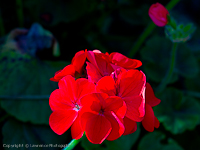 Panasonic GF1 micro four thirds
digital camera and
a Panasonic Lumix 14-45mm zoom lens. The GF1 combo is surprisingly adept
at close up shots with the lens image stabilisation performing very
well. The original colour 'RAW' image file was very sharp.
The
shot was taken hand held at 45mm (90mm field of view). The original shot
settings are ISO:100, aperture f5.6 and shutter speed 1/160secs.
I cropped and
softened it in Adobe Lightroom Software and it seems fairly reasonable?
I like the colour and the effect but I am not sure it can be called
'Photographic Art'? Panasonic GF1 micro four thirds
digital camera and
a Panasonic Lumix 14-45mm zoom lens. The GF1 combo is surprisingly adept
at close up shots with the lens image stabilisation performing very
well. The original colour 'RAW' image file was very sharp.
The
shot was taken hand held at 45mm (90mm field of view). The original shot
settings are ISO:100, aperture f5.6 and shutter speed 1/160secs.
I cropped and
softened it in Adobe Lightroom Software and it seems fairly reasonable?
I like the colour and the effect but I am not sure it can be called
'Photographic Art'?
I like this
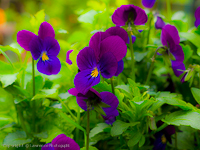 purple
flower image,
another garden shot using the GF1
camera and the Lumix 14-45mm Lens.
The original shot settings are ISO:200, aperture f8 and shutter speed
1/80secs.
Again this was softened and modified using Lightroom software to develop
the 'RAW' file.
I like the way the colours have blended in whilst the
centre of the image retains a reasonable sharpness. With the correct GF1
profile in Lightroom the conversion produces a very nice effect. purple
flower image,
another garden shot using the GF1
camera and the Lumix 14-45mm Lens.
The original shot settings are ISO:200, aperture f8 and shutter speed
1/80secs.
Again this was softened and modified using Lightroom software to develop
the 'RAW' file.
I like the way the colours have blended in whilst the
centre of the image retains a reasonable sharpness. With the correct GF1
profile in Lightroom the conversion produces a very nice effect.
It could be argued that even a point and shoot camera is capable of
capturing images whereby they can be turned into works of art. I believe
 for a great number of images such as landscapes and images with a
reasonable depth of field a point and shoot camera could be used,
providing the photographer has a good eye and is proficient in post
processing software.
I would add that a point and shoot that can capture
'RAW' files would be preferable! for a great number of images such as landscapes and images with a
reasonable depth of field a point and shoot camera could be used,
providing the photographer has a good eye and is proficient in post
processing software.
I would add that a point and shoot that can capture
'RAW' files would be preferable!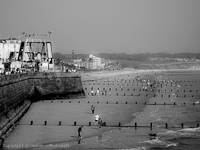
This image of the beach at Bridlington on the East Coast of England was
taken using a Canon IXUS 12MPixel sensor 960 IS digital camera. It is a
standard camera colour jpeg developed again in Lightroom, softened and cropped
for effect.
I also converted it to black and white using Lightroom. It
becomes alive when it is blown up to about an A3 size print
and you stand back from the wall to view it.
The beach shot image settings are ISO:80, aperture f5.8 and
shutter speed 1/400secs.
This image of Frances
and Alistair was captured using Kodak colour film and a film SLR camera.
It was digitally scanned using a Canon FS4000US scanner and then post processed
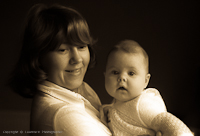 in Lightroom 3
software. The resulting image was heavily softened and the eyes of the
child were sharpened for effect.
This
image comes alive when it is
viewed from a distance and in particular when it is a large print on the
wall.
The poignancy of this image is that I captured it back in 1980 and
tragically a few years later, Alistair, a beautiful child, passed on. in Lightroom 3
software. The resulting image was heavily softened and the eyes of the
child were sharpened for effect.
This
image comes alive when it is
viewed from a distance and in particular when it is a large print on the
wall.
The poignancy of this image is that I captured it back in 1980 and
tragically a few years later, Alistair, a beautiful child, passed on.
This next image was captured
using a Canon 5D Mk1 DSLR and a
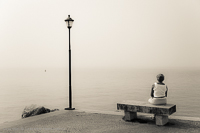 Canon
24-105mm L Lens. It is a picture of a girlfriend and yes, it is posed
for deliberately. Carol is attractive but the desired effect was for her
to gaze out on Lake Garda showing her back to the camera. I called the
shot 'Distant Memories'. This is one image that I think is close to what
I would call 'Photographic Art'. It is minimalistic and it could be
interpretated as a woman sitting quietly, gazing out onto the still
expanse of water and reflecting back on the expanse of her life and the
poignant memories. The original shot settings are ISO:200, aperture f4
and shutter speed 1/1600secs. Canon
24-105mm L Lens. It is a picture of a girlfriend and yes, it is posed
for deliberately. Carol is attractive but the desired effect was for her
to gaze out on Lake Garda showing her back to the camera. I called the
shot 'Distant Memories'. This is one image that I think is close to what
I would call 'Photographic Art'. It is minimalistic and it could be
interpretated as a woman sitting quietly, gazing out onto the still
expanse of water and reflecting back on the expanse of her life and the
poignant memories. The original shot settings are ISO:200, aperture f4
and shutter speed 1/1600secs.
When you start out to change your style of photography and attempt to
move towards more artistic images it can be extremely difficult to find
the material. A lot of the images in this article were shot a while ago
for effect and feature in my web as standard colour images. I had tried
my hand before at modifying them using 'Buzz Software' which was a
failure but it was
only when I started to use Lightroom that I had some software tools to
create some sort of artistic effect that could hold up on the wall as a
print. I have a feeling that once this terrible winter is over,
photographic art images, may be thin on the ground. I am sure this is
why so many photographers 'stage' their art photography.
Resolution V Noise v
Print Size
Like every other
image, I determine the final size by the required print
size or perhaps by the size it will be displayed on a digital screen.
This for me is what determines the noise versus resolution quality because a
great deal depends on the actual viewing distance? Fortunately with most
photographic art, the resolution versus noise ratios are less of a
problem as most images are reduced in resolution for effect and for
greater viewing distances. I am sure that many professional photographic
artists who modify their images use soft lenses on their cameras. Some
lenses like the Zeiss 50mm 'Sonnar' ZM (Leica mount) actually deliver
crisp sharpness but with a very smooth outline, which can with the
correct settings, take the image a long way into an art form, even
before post processing is applied.
Street Photography &
Varying Tastes
People have varying tastes as to what image can be classed as
photographic art and very often it is not the finish of the image but
what it portrays that dictates its acceptance. Street photography can be
hit or a miss, especially in monochrome and the accepted image can be
sharp, hazed, blown out.................it seems to be the message that
is delivered more than the quality of the image? Personally, I have
never been in the mindset of the art critics and sometimes they seem to
lose the plot in their endeavors to explain the art form.
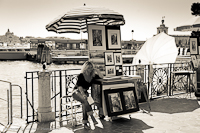 I
often imagine that Picasso, once he was accepted, was often 'doubled up
with laughter' at the thought of what art critics would 'exclaim'
regarding one of his wayward brush strokes. I
often imagine that Picasso, once he was accepted, was often 'doubled up
with laughter' at the thought of what art critics would 'exclaim'
regarding one of his wayward brush strokes.
I captured this image in Venice and I admit, I have messed about with it
for years in software to achieve some sort of effect. When I saw her
sitting there, she really looked fed up and she had a piece of paper in
her hand. I figured the paper was a note from her boyfriend
giving her the brush off. She is a beauty and I am probably completely
wrong but 'Dumped in Venice' is what I saw in the shot. The image was captured using a
Canon 5D Mk1 DSLR with a Canon 24-105mm L Lens. It was converted to black and
white in Lightroom and softened for effect. The 'art' is
supposed to be in the interpretation, so I guess it could have left
it sharp? The original shot settings are ISO:200, aperture f4 and shutter
speed 1/1600secs.
This image was again captured in Venice and it was originally a colour
shot using
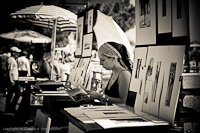 Canon
5D Mk1 DSLR with a Canon 24-105mm L Lens which is not half bad for out of focus shots and makes a
great travel lens. The girl appeared to be having a break or perhaps she
was fed up with the lack of customers, in any case it captures a nice
moment and the image has some background depth which I like. I am
not sure that it is photographic art? The image was captured in colour,
converted to black and
white in Lightroom and softened for effect. The original shot settings
are ISO:200, aperture f4 and shutter speed 1/1600secs. Canon
5D Mk1 DSLR with a Canon 24-105mm L Lens which is not half bad for out of focus shots and makes a
great travel lens. The girl appeared to be having a break or perhaps she
was fed up with the lack of customers, in any case it captures a nice
moment and the image has some background depth which I like. I am
not sure that it is photographic art? The image was captured in colour,
converted to black and
white in Lightroom and softened for effect. The original shot settings
are ISO:200, aperture f4 and shutter speed 1/1600secs.
The
'Artists' Eye for Interpretation and Post Processing
Throwing away the technical and concentrating on the art composition
with an eye for the final post processed product is extremely difficult.
I keep seeking 'the minimalistic' image that conveys a message and yet
is simplistic in its content to deliver that message. Whether it is a
street image or landscape or sometimes a combination of both the road is
a troublesome one..............whoa, I'm turning into an
artist, I'm going to cut of my ear and freak out with the load I
carry for my art..........I don't think so!
 This
image was originally captured in colour and was extreme in its
sharpness. Its my idea of minimalistic content but has so many facets to
take in. Taken a few years ago at Lazise, Lake Garda, Italy, I recently
re-visited it with Lightroom and softened it for effect. The choice of
scene was deliberate but unlike the image of Carol above, it was not
staged. The original image was a nice picture and captured the moment
well, the baby buggy, the kids at the edge of the walkway overlooking
the lake, the yacht with the red sail, the young lovers on the chair
with their cycles parked up and the tree with the litter bin. I think
the ornate lamp posts finished it off nicely and yet it remains quite
uncluttered. This
image was originally captured in colour and was extreme in its
sharpness. Its my idea of minimalistic content but has so many facets to
take in. Taken a few years ago at Lazise, Lake Garda, Italy, I recently
re-visited it with Lightroom and softened it for effect. The choice of
scene was deliberate but unlike the image of Carol above, it was not
staged. The original image was a nice picture and captured the moment
well, the baby buggy, the kids at the edge of the walkway overlooking
the lake, the yacht with the red sail, the young lovers on the chair
with their cycles parked up and the tree with the litter bin. I think
the ornate lamp posts finished it off nicely and yet it remains quite
uncluttered.
I also converted it to monochrome in Lightroom and gave it a
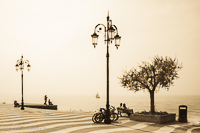 slight
glow in the softening. It looks a bit more 'old world' which I prefer to
the colour conversion. The image was captured using a Canon 5D Mk1 DSLR
with a Canon 24-105mm L Lens. The original shot settings are
ISO:320, aperture f14 and shutter speed 1/250secs. slight
glow in the softening. It looks a bit more 'old world' which I prefer to
the colour conversion. The image was captured using a Canon 5D Mk1 DSLR
with a Canon 24-105mm L Lens. The original shot settings are
ISO:320, aperture f14 and shutter speed 1/250secs.
I used the same approach for the
next colour shot which was taken in Cairo but again Carol was
deliberately placed into the scene with her floppy straw hat. The sun was
bouncing off the buildings and the shadows created a nice effect around
the chairs. I called it 'A Girl in Cairo' although perhaps 'Alone in
Cairo' would have suited the image better
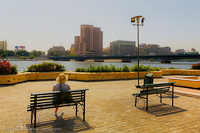 but
she was not alone, she was with me, so it did not fit my perception of
the moment. but
she was not alone, she was with me, so it did not fit my perception of
the moment.
The modified colour version warmed up quite
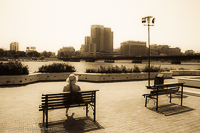 nicely
but
I also converted it to monochrome in Lightroom. The original image was captured using a Canon 5D Mk1 DSLR
with a Canon 24-105mm L Lens. The original shot settings are
ISO:100, aperture f11 and shutter speed 1/125secs. Both images have
been softened, cropped and the highlights lifted to create more of a
glow. nicely
but
I also converted it to monochrome in Lightroom. The original image was captured using a Canon 5D Mk1 DSLR
with a Canon 24-105mm L Lens. The original shot settings are
ISO:100, aperture f11 and shutter speed 1/125secs. Both images have
been softened, cropped and the highlights lifted to create more of a
glow.
The above shots at Lake Garda and Cairo could be 'classed' as street
photography but the next image
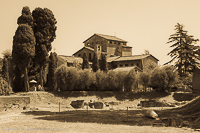 moves
away more towards a landscape. It was taken in Rome within the grounds
of the forum and it is a picture of a Roman villa. The ruins in the
foreground provide some depth and I think add character to the scene.
Its not so minimalist but it is timeless in appearance, unless you
look very carefully at the people in it. moves
away more towards a landscape. It was taken in Rome within the grounds
of the forum and it is a picture of a Roman villa. The ruins in the
foreground provide some depth and I think add character to the scene.
Its not so minimalist but it is timeless in appearance, unless you
look very carefully at the people in it.
The original colour image was captured using a Canon 5D Mk1 DSLR
with a Canon 24-105mm L Lens. The original shot settings are
ISO:100, aperture f8 and shutter speed 1/160secs.
This next shot was opportunistic as I stopped the car and snapped it as
I walked back towards the bridge.
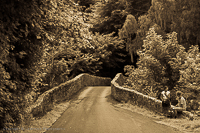 I
spoke briefly to the couple, who were Americans, visiting Peebles on
holiday. The sad part regarding this image is that the 'Manor Bridge' near
Peebles in Scotland is an extremely old bridge with a couple of
centuries flowing under its arch and now it is boarded off and declared
unsafe.................so much for the protection of heritage! I
spoke briefly to the couple, who were Americans, visiting Peebles on
holiday. The sad part regarding this image is that the 'Manor Bridge' near
Peebles in Scotland is an extremely old bridge with a couple of
centuries flowing under its arch and now it is boarded off and declared
unsafe.................so much for the protection of heritage!
The original colour image was captured using a Canon 5D Mk1 DSLR
with a Canon 24-105mm L Lens. The original shot settings are
ISO:200, aperture f8 and shutter speed 1/60secs.
During the heavy snowfall in December 2010, I was out in the fields with
my GF1 camera and Lumix 20mm f1.7 Lens when I captured this next shot.
It was a glorious day as
 the
sun shown through the clouds, blue sky and the snow was reflective. the
sun shown through the clouds, blue sky and the snow was reflective.
I love that GF1 camera and
lens; compact, light and yet it delivers awesome sharpness in the 'RAW'
file images. A classic 40mm field of view from the 2x crop sensor and
some say, me included, that 40mm is the 'sweet spot' between the 35mm
and 50mm focal range.
The original shot settings are ISO:100, aperture f4 and shutter speed
1/1600secs.
I converted the colour 'RAW' in Lightroom to monochrome, softened it and
I think it displays enough depth of content to draw in the viewers eye.
It is a timeless image as the barns are derelict and ruined, the large trees are
over 2 hundred years old and it is in a conservation area. The scene
has hardly changed, even the original stone dyke remains from yester
year.
Its hard to determine if any of it would pass for photographic art, does
it make a statement, does it have hidden content...............I guess
it is just different to what I usually produce and I remain content with
that!
Associated Articles -
If you have enjoyed this article - please donate to my
Charity of Choice - The Sick Kids
Richard Lawrence
Scotland
United Kingdom
Back to Articles Page |














